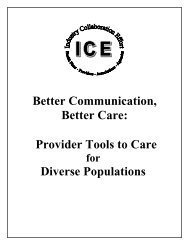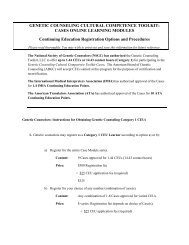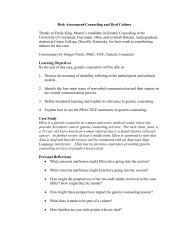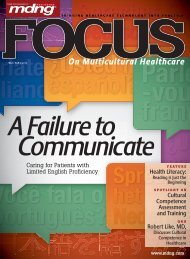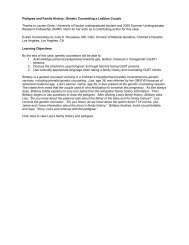Advanced Effective Communication, Cultural Competence, and ...
Advanced Effective Communication, Cultural Competence, and ...
Advanced Effective Communication, Cultural Competence, and ...
You also want an ePaper? Increase the reach of your titles
YUMPU automatically turns print PDFs into web optimized ePapers that Google loves.
A Roadmap for Hospitals<br />
Chapter Six: Organization Readiness<br />
✔ Checklist for Organization<br />
Readiness (continued)<br />
Provision of Care, Treatment, <strong>and</strong> Services<br />
❑ Create an environment that is inclusive<br />
of all patients.<br />
❑ Develop a system to provide language<br />
services.<br />
❑ Address the communication needs of<br />
patients with sensory or communication<br />
impairments.<br />
❑ Integrate health literacy strategies into<br />
patient discussions <strong>and</strong> materials.<br />
❑ Incorporate cultural competence <strong>and</strong><br />
patient- <strong>and</strong> family-centered care<br />
concepts into care delivery.<br />
Patient, Family, <strong>and</strong> Community<br />
Engagement<br />
❑ Collect feedback from patients, families,<br />
<strong>and</strong> the surrounding community.<br />
❑ Share information with the community<br />
about the hospital’s efforts to meet<br />
unique patient needs.<br />
address, the example practices <strong>and</strong> methods may not apply to<br />
all hospital types, sizes, or settings.<br />
Recommended Issues <strong>and</strong><br />
Related Practice Examples to<br />
Address the Leadership Domain<br />
of Organization Readiness<br />
❑ Demonstrate leadership commitment to<br />
effective communication, cultural<br />
competence, <strong>and</strong> patient- <strong>and</strong> familycentered<br />
care.<br />
The buy-in <strong>and</strong> support from hospital leaders make it<br />
easier to allocate resources <strong>and</strong> provide services necessary<br />
to meet patient communication, cultural, religious,<br />
spiritual, mobility, or other needs.<br />
• Involve staff at all organization levels in decision<br />
making.<br />
• Encourage leaders to participate in interdisciplinary<br />
patient rounds.<br />
• Communicate leadership commitment to effective<br />
communication, cultural competence, <strong>and</strong> patient<strong>and</strong><br />
family-centered care during new staff orientation.<br />
• Create opportunities for leaders to engage staff on a<br />
regular <strong>and</strong> ongoing basis (for example, establish<br />
“office hours” with executives or breakfast with the<br />
President [6]).<br />
• Identify an individual(s) directly accountable to<br />
leadership for overseeing hospital efforts to advance<br />
effective communication, cultural competence, <strong>and</strong><br />
patient- <strong>and</strong> family-centered care.<br />
• Incorporate community benefit reporting into the<br />
design <strong>and</strong> implementation of services that address<br />
barriers to care (as required of non-profit hospitals by<br />
the Internal Revenue Service [7]).<br />
• Integrate the Office of Minority Health’s National<br />
St<strong>and</strong>ards for <strong>Cultural</strong>ly <strong>and</strong> Linguistically Appropriate<br />
Services (known as the CLAS st<strong>and</strong>ards) into the<br />
hospital’s services, programs, <strong>and</strong> initiatives [8].<br />
❑ Integrate unique patient needs into new<br />
or existing hospital policies.<br />
Hospitals should develop new or modify existing policies<br />
<strong>and</strong> procedures to incorporate the concepts of effective<br />
communication, cultural competence, <strong>and</strong> patient- <strong>and</strong><br />
family-centered care.<br />
• Incorporate information about providing communication<br />
assistance to patients whose preferred language is not<br />
English or who have sensory or communication impairments<br />
into applicable hospital policies <strong>and</strong> procedures.*<br />
• Define family to explicitly include any individual that<br />
plays a significant role in the patient’s life such as<br />
spouses, domestic partners, significant others (of both<br />
different-sex <strong>and</strong> same-sex), <strong>and</strong> other individuals not<br />
legally related to the patient. Use this exp<strong>and</strong>ed definition<br />
in all hospital policies, including those addressing<br />
visitation, access to chosen support person, identification<br />
of surrogate decision-makers <strong>and</strong> advance directives. †<br />
* See the Chapter 6: Organization Readiness: Provision of Care, Treatment, <strong>and</strong> Services (page 40 <strong>and</strong> 41) for additional information on providing<br />
language services <strong>and</strong> communication assistance.<br />
† On April 15, 2010, President Obama released a presidential memor<strong>and</strong>um for the secretary of the Department of Health <strong>and</strong> Human Services<br />
respecting the rights of hospital patients to receive visitors <strong>and</strong> to designate surrogate decision-makers for medical emergencies regardless of their<br />
status of legally recognized immediate family members (available at http://www.whitehouse.gov/the-press-office/presidential-memor<strong>and</strong>umhospital-visitation).<br />
(Accessed on July 22, 2010.)<br />
34


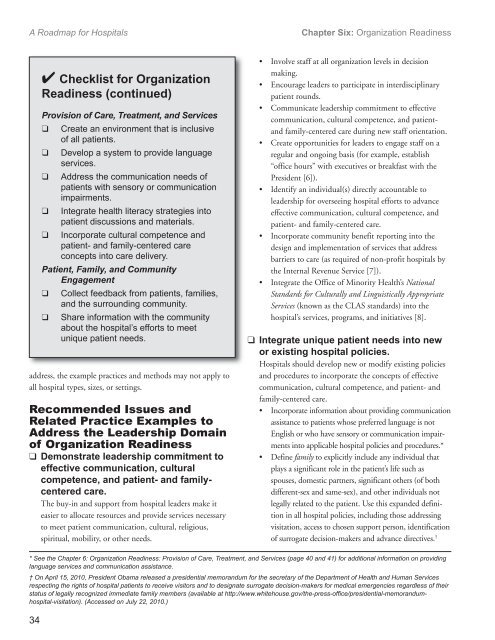
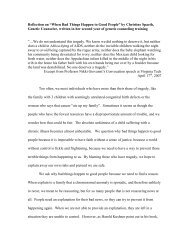
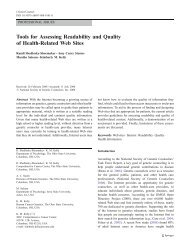

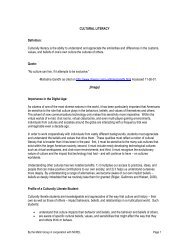
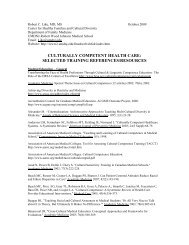

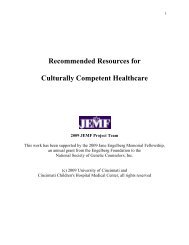

![Breaking Bad News PPT[1] - Genetic Counseling Cultural ...](https://img.yumpu.com/35003134/1/190x146/breaking-bad-news-ppt1-genetic-counseling-cultural-.jpg?quality=85)
